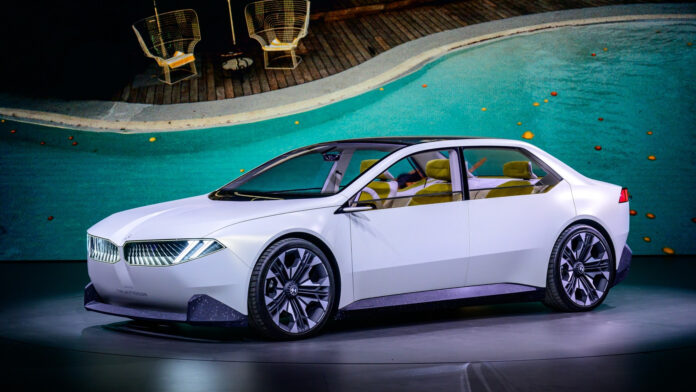BMW Group has extended a cloud computing and services partnership with Amazon Web Services (AWS) to deliver various IoT and AI capabilities to extend driver assistance (ADAS) features in new vehicles launching in 2025. The German automaker has also confirmed it is working with Qualcomm Technologies to develop automated driving systems based on the California firm’s Snapdragon Ride computer vision platform.
The arrangement with AWS draws on a “pre-existing” ‘cloud data hub’, already on AWS; It will make new usage of cloud-based compute and storage, plus also IoT sensing and AI sense-making tools, including generative AI and machine learning. BMW’s focus is on its Neue Klasse line (pictured), available from 2025, which will draw on enhanced onboard ASAS sensors and software to provide driver warnings, automated braking, and steering functions.
BMW said it will make use of AWS’s public cloud functions for the ongoing design and lifecycle management of the new ADAS platform. It said: “BMW engineers can respond more quickly to customer demands and deliver new features to help improve the driving experience. This efficiency, supported by the cloud, will help BMW continue to innovate features for its Neue Klasse of vehicles and keep drivers focused on the experience on the road.”
It will use the Snapdragon Ride platform to integrate 360-degree AI-augmented video (computer vision) functionality into new vehicles, to underpin automated driving functions. It re-stated that the twin deals with AWS and Qualcomm are geared towards production, in the first instance; usage of the public cloud, at least, is not so easily rationalised in automated systems to control and manage the live operation of vehicles.
Centralised cloud compute can “help scale… capacity to handle vast increases in data… within automated driving feature development”, said BMW, pointing to the upsurge with higher-level automated functions, such as adaptive cruise control, parking assist, and piloted driving. “Vehicles create more data for engineering teams to analyse and utilise,” it said, noting development of new hands-free features, such as automated lane changing.
Its new driving platform will represent a common reference architecture for the development of other BMW models, too, and a way to process, catalogue, and store “millions of miles of real-time driving data” in AWS’s Amazon S3 cloud storage engines – for engineers to identify and visualise relevant driving scenes to develop and train models using its edge/cloud SageMaker machine learning service.
There was a hint in the press statement about the potential of digital twinning in the BMW design factory, as well. The statement said: “Engineers can also develop large-scale simulations on AWS compute instances for verification. With this approach, the group can test and validate new software versions more efficiently, helping to ensure the system’s safety and shortening time to market.”
The statement explained: “With AWS and Qualcomm, BMW’s engineers have access to leading hardware, vision software, and cloud capabilities in an end-to-end automated driving development platform. Placing BMW’s automated driving platform in the cloud helps break down development silos within vehicle software teams at the group and helps foster greater global collaboration with suppliers to accelerate automated driving innovation.”
Nicolai Martin, senior vice president for driving experience at BMW, said: “In the next decade, consumer habits and expectations will drive more changes in the automotive industry than we’ve seen over the past 30 years. This is just the beginning of a new era of highly automated driving, fueled by innovations in technology and engineering… BMW, with Qualcomm… is building our new automated driving platform on AWS’s scalable, secure, and reliable infrastructure… – to empower the next generation of BMW’s automated driving and parking functions.”
Wendy Bauer, general manager of automotive and manufacturing at AWS, said: “Automated driving is about more than just convenience; it’s also aimed at providing driver assistance technology that helps prevent injuries and saves lives. Implementing these systems on the BMW Group’s international scale requires an approach that can process and analyse vast amounts of data, as well as learn and innovate, so automakers can develop safer and more reliable automated and ADAS systems.”
Nakul Duggal, senior vice president for automotive and cloud computing at Qualcomm, said: “As the automotive industry evolves toward a new high-performance, low-power, and highly scalable software-defined vehicle architecture, we are proud to continue our… cooperation with BMW to co-develop safer and more secure AI-powered driver assistance technologies at scale… This relationship with AWS and BMW brings together leading-edge technologies from our industries to deliver a modern cloud-native software development environment.”

